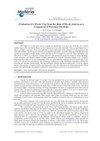单宁-甲醛体系碳干凝胶作为催化剂载体的研究与表征
IF 1.2
4区 材料科学
Q4 MATERIALS SCIENCE, MULTIDISCIPLINARY
引用次数: 1
摘要
这篇文章报道了使用一种有机凝胶,干凝胶,作为铜的催化剂载体。以F-127 Pluronic为表面活性剂,在pH为3的条件下合成了单宁-甲醛体系的干凝胶。铜(10%,wt)浸渍后,其表面积值仍高于900 m2/g。SEM-FEG形貌分析显示,微球呈三维结构排列。XRD衍射图显示,多孔碳中存在CuO和Cu2O结晶相,并伴有非晶态结构。从XRD分析可以推断出Cu在载体上呈非均质分散,大小团簇共存,这与拉曼光谱结果一致。Raman研究还表明,该干凝胶衍生物具有高度的缺陷/无序结构,遵循碳结构和氧基团修饰碳表面的短程结构顺序。XPS结果与XRD和Raman结果相一致,检测到CuO和Cu2O的存在。除上述Cu外,XPS还检测到Cu0,这可能是由电子氧基与Cu前驱体之间的化学相互作用产生的。Cu/XCTF的高表面积和热稳定性(~ 300℃)使其在相关催化应用中具有可行性。关键词:碳干凝胶,单宁,再生工艺,催化剂载体。本文章由计算机程序翻译,如有差异,请以英文原文为准。
Study and characterization of carbon xerogels from tannin-formaldehyde system as catalyst support applications
This contribution reports the use of an organic gel, xerogel, as catalyst support for Cu. The xerogel was synthesized from the system tannin-formaldehyde at pH 3, using F-127 Pluronic as surfactant. The surface area values were higher than 900 m2/g even after the Cu (10%, wt) impregnation. The morphological analysis by SEM-FEG revealed the presence of spheres arranged in a tridimensional structure. XRD diffractograms showed the presence of CuO and Cu2O crystalline phases combined with the amorphous structure of the porous carbon. From XRD analysis it is possible to infer the Cu species are heterogeneously dispersed on the support with the co-existence of small and larger clusters, which is in agreement with Raman spectroscopy. Raman study also indicated a highly defect/disorder structure of the xerogel derivatives, ensuing the short-range structural order of the carbonic structure and oxygen groups decorating the carbon surface. XPS results corroborate with XRD and Raman results, detecting the presence of CuO and Cu2O. In addition to the mentioned Cu species, XPS also detected Cu0 which may be originated from the chemical interaction between the electron oxygen groups with the Cu precursor. The high surface area and the thermal stability (~ 300 oC) of Cu/XCTF envisages its feasibly for relevant catalytic applications. Keywords: Carbon xerogels, tannin, renewable process, catalyst support.
求助全文
通过发布文献求助,成功后即可免费获取论文全文。
去求助
来源期刊

Materia-rio De Janeiro
MATERIALS SCIENCE, MULTIDISCIPLINARY-
CiteScore
1.00
自引率
25.00%
发文量
51
审稿时长
6 weeks
期刊介绍:
All the articles are submitted to a careful peer-reviewing evaluation process by the journal''s Editorial Board. The Editorial Board, reviewers and authors make use of a web based proprietary automated tool to deal with the reviewing procedures.the Revista Matéria''s article reviewing restricted access system - SEER. Authors are not informed about the identity of the reviewers.
 求助内容:
求助内容: 应助结果提醒方式:
应助结果提醒方式:


